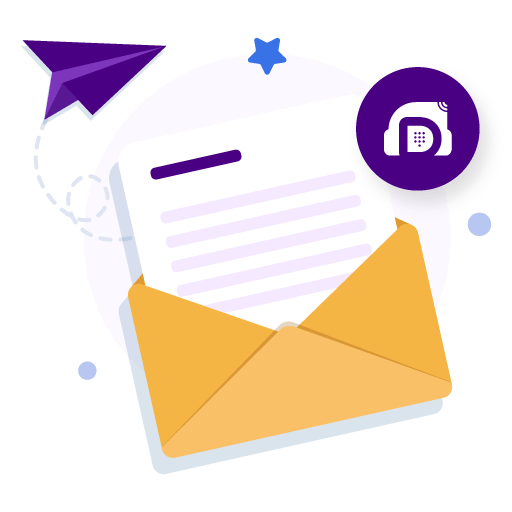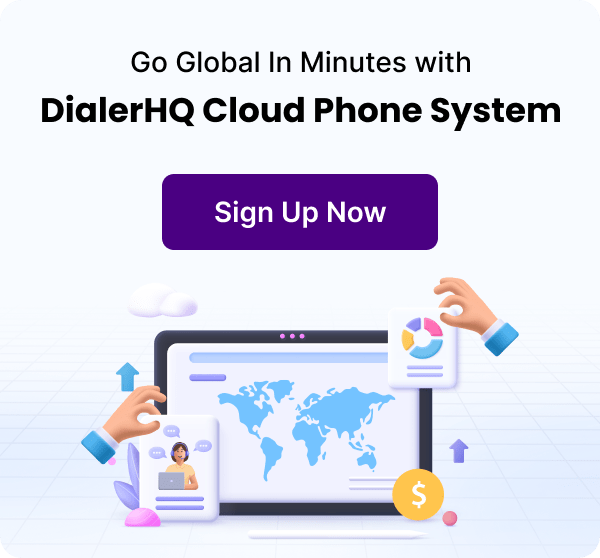Senior Writer: Rohit Rajpal
Handling customers over the phone is far from easy. Agents must be prepared to handle customer questions on various topics, often with little time to prepare between calls. This means they need to have extensive product knowledge and quick-thinking skills. The complexity amplifies when considering that a staggering 71% of customers today anticipate tailored and personalized interactions.
However, even experienced agents sometimes struggle to find the right information when faced with an unfamiliar or complex inquiry. This is where Call Whisper comes in. It gives agents key customer data before or during a call through screen pops, voice recordings, or real-time coaching from a manager that only the agent can hear.
"Train your managers on providing effective real-time guidance through call whisper. Invest in continuous training and refinement of call whisper practices to make the most out of this valuable tool, resulting in improved customer interactions and agent performance."
Let’s understand call whisper in-depth, including how it works and why you must invest in call whispering!
What is a Call Whisper?
Call Whisper is an innovative call center technology that empowers agents with the right information at the right time during customer interactions. It uses audio feeds, screen pops, and real-time coaching to silently provide agents with customer data and suggested responses without the customer hearing. This equips agents to have more personalized, effective conversations that drive greater first-call resolution, customer satisfaction, and employee productivity.
There are two main types of call whisper functionality:
- Standard Call Whisper: Gives agents key customer information like account data or IVR selections through screen pops or pre-call recordings. This lets them prepare right when the call starts.
- Live Call Whisper: A supervisor listens in real-time and whispers coaching tips and suggested responses directly to the agent as the call happens. This enables personalized guidance at the moment the agent needs it most.
How does Call Whisper Work?
Call whisper works with other call center software features, like call barging, call routing, and auto dialer tools. Here’s a step-by-step process on how the call whisper works.

- Agent receives a call: When an agent receives an incoming call, the system’s AI or a supervisor can activate a call whisper feature.
- AI-powered whisper: Using speech recognition and NLP, Call Whisper’s AI automatically generates relevant whispers to the agent based on call context and historical interactions.
- Supervisor’s input: The manager looks at the list of active calls and selects the one they want to supervise. If required, they provide the agent instructions, tips, or information without the caller hearing anything.
It is worth noting that the exact working process of the call whisper feature depends on the platform you use, call volume, or the number of available managers. However, the steps mentioned above are the most common course of action.
What is the Difference Between Call Whispering and Call Monitoring?
Call whispering provides real-time assistance and guidance to agents during calls to improve their performance. In contrast, call monitoring is a broader function used for various purposes, including quality control and performance evaluation, often without direct interaction with the agent during the call.
1. Purpose
Call whispering is primarily used to provide real-time assistance and coaching to a call center agent during a live call with a customer. The agent can receive guidance or information without the customer hearing it. It’s meant to improve the agent’s performance and help them handle the call more effectively.
On the other hand, call monitoring is a broader feature that allows supervisors or managers to listen in on calls in real time or review recorded calls. This helps in quality control, training, compliance, and performance evaluation. It may or may not involve providing immediate feedback to the agent.
2. Agent Awareness
In call whispering, the agent knows they are receiving assistance or coaching during the call. They can hear the whispered instructions or see messages on their screen.

However, in call monitoring, the agent may not be aware that their call is being monitored, especially if it’s done for quality control or training purposes. The monitoring is typically for evaluation rather than immediate assistance.
3. Use Cases
Call whispering enhances agent performance by providing real-time support for challenging or complex calls. It helps agents handle calls more effectively, especially if they are relatively new or require assistance with specific issues.
On the other hand, call monitoring is used for various purposes, including quality assurance, compliance checks, training, and performance evaluations. It can also assess overall call center performance and customer interactions.
| Feature | Call Whispering | Call Tracking | Call Monitoring |
|---|---|---|---|
| Main Function | Enables organizer to guide agents during calls. | Tracks the journey of incoming calls. | Recorded calls for quality checks. |
| Key Purpose | Give support to agents to improve call handling. | Analyzes call sources and customer engagement. | Assesses call quality, and agent performance. |
| Benefit to Agent | Provide Support during the customer calls. | Collect data on customer demographics. | Offers feedback for skill improvement. |
| Benefit to Supervisory | Live calls for timely intervention and support. | Gives insights into marketing effectiveness. | Enhances agent performance and service quality. |
| Impact on Customer | Improves call experience with well-supported agents. | Enhances marketing relevance and the customer experience. | Improves consistent service quality by quality assessments. |
What are the Benefits of Call Whispering?
Call whispering benefits both sales professionals and customer service agents by improving their performance, ensuring consistency, and enhancing the overall quality of service. Here’s how!
Benefits of Call Whispering for Sales Professionals
Sales professionals often use call whispering as a valuable tool to optimize their interactions with potential clients. Here are some specific benefits for sales teams:

1. Real-time Guidance
Call whispering allows sales managers or experienced team members to provide real-time guidance to sales representatives during live calls with prospects. This guidance can include tailored product suggestions, objection-handling techniques, and closing strategies.
2. Enhanced Training
For new sales hires, call whispering serves as an on-the-job training mechanism. Salespeople can learn from experienced colleagues or supervisors while engaging with customers, helping them quickly adapt to the nuances of the sales process.
3. Increased Confidence
Sales representatives may face rejection or objections during calls. However, agents can confidently approach calls, knowing they have support readily available through call whispering. This can be especially beneficial when handling difficult prospects, as agents are less likely to feel overwhelmed or stressed.
4. Customized Sales Pitches
With call whispering, sales managers can provide customized sales pitches based on the specific needs and preferences of the prospect. This level of personalization can significantly improve the chances of closing a deal.
5. Higher Conversion Rates
The real-time advice and guidance offered through call whispering can increase conversion rates. Sales professionals can more effectively address prospect concerns, leading to more successful sales outcomes.
Benefits of Call Whispering for Customer Support Professionals:
Customer support professionals also reap distinct advantages from call whispering in their daily roles. Here are some benefits.

1. Complex Issue Resolution
Support agents often encounter complex customer issues. Call whispering enables supervisors or specialized support teams to provide immediate assistance, ensuring that even the most challenging problems are resolved swiftly and accurately.
2. Quality Assurance
Call whispering serves as a quality control mechanism. Supervisors can monitor support calls in real time to ensure that agents adhere to company guidelines and maintain a high standard of service quality.
3. Enhanced Training and Onboarding
New support agents can benefit from call whispering as it facilitates their training and onboarding process. They can learn from experienced agents while handling real customer inquiries.
4. Reduced Escalations
Call whispering helps support agents handle customer inquiries effectively, reducing the need to escalate calls to higher-tier support teams. This not only streamlines the support process but also minimizes customer frustration.
5. Personalized Assistance
Agents can receive personalized guidance on how to handle specific customer issues. Call whispering ensures that customers receive tailored assistance, whether it’s account troubleshooting or technical support.
6. Improved First-Contact Resolution
With call whispering, customer support professionals are better equipped to address and resolve customer issues during the initial contact. They can access guidance and expertise as needed, allowing them to provide comprehensive solutions to customers’ inquiries or problems right away.
How does Call Whispering Improve Your Agent’s Performance?
Call whispering improves your agents’ performance in a call center or customer service environment. Here’s how call whispering can enhance your agent’s performance:

1. Real-time Guidance and Coaching
Call whispering allows managers or experienced team members to provide real-time guidance and coaching to agents during live customer calls. They can offer insights, suggestions, or answers to questions, helping agents navigate complex or challenging situations.
2. Customized Responses
Call whispering enables managers to provide agents with customized responses based on the specific needs and preferences of the customer. Agents can tailor their interactions to align with individual customer profiles, leading to more effective communication and increased chances of success.
3. Quality Control
Call whispering also serves as a quality control mechanism. Managers can monitor calls to ensure agents adhere to company policies, scripts, and quality standards. This helps maintain a consistent level of service quality across all customer interactions.
4. Immediate Feedback
Agents receive immediate feedback after each call, allowing them to reflect on their performance while the call is still fresh in their minds. This immediate feedback loop encourages agents to identify areas for improvement and make real-time adjustments.
5. Continuous Learning
Call whispering fosters a culture of continuous learning within the call center. Agents can learn from each call and apply those lessons to subsequent interactions, gradually refining their skills and becoming more proficient at handling a variety of customer scenarios.
Conclusion
With Call Whisper, professionals across industries can handle client interactions with greater confidence, empathy, and effectiveness. Seamless access to data, suggested responses, and expert advice is now possible without clients ever knowing. Besides, it helps train and enhance agents, improving their performance over time – a win-win for customers and companies.
Frequently Asked Questions
A call whisper message provides call center agents and customer service reps with real-time guidance, suggestions, and information during calls to improve first-call resolution rates and customer satisfaction.
No, the call whisper is not audible to the customer. The "whisper" prompts are transmitted only to the agent via a separate audio channel. The customer only hears the normal conversation with the agent.
Yes, call whisper can be implemented in a VoIP phone system environment. The whisper audio can be injected into the agent's VoIP phone call separately without the customer hearing it. Leading VoIP providers like DialerHQ offer the call whisper feature in their plans, so you don’t have to purchase it additionally.
Call barging allows a supervisor to join an active call with the customer hearing. However, call whisper provides coaching guidance privately to just the agent. The customer is unaware of the whisper assisting the agent.
Rohit Rajpal simplifies intricate technical ideas into practical insights through his articles and publications. His journey in VoIP and cloud telephony reflects a profound grasp of the evolving landscape, a flair for innovation, and a dedication to creating user-friendly blogs. Rohit’s broad expertise encompasses VoIP protocols, codecs, and cloud-based telephony systems, ensuring accessible knowledge for all.
Updated : May 10, 2024

Subscribe to our newsletter & never miss our latest news and promotions.





